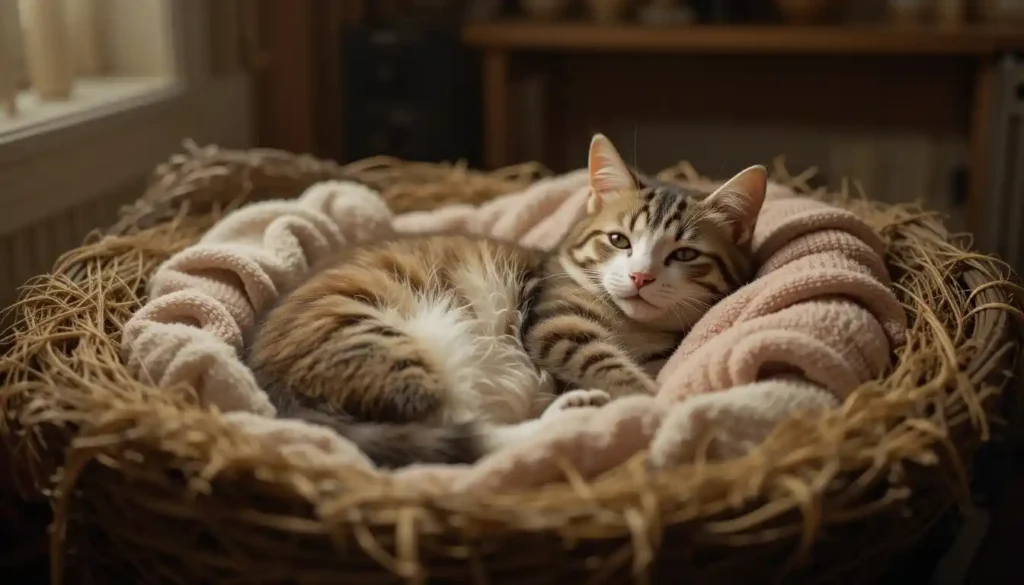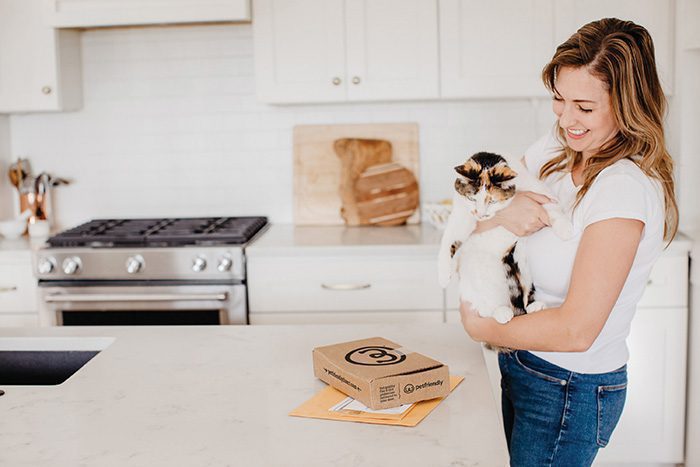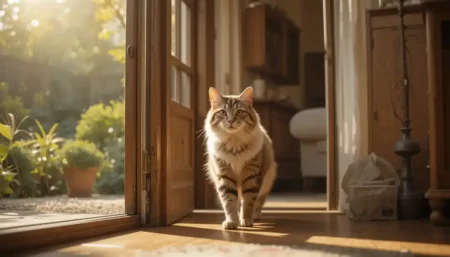A cat pregnancy lasts 63-67 days with clear physical and behavioral changes. Early signs include enlarged nipples and increased appetite.
Your cat’s sudden interest in quiet corners and increased napping might signal something amazing—a potential cat pregnancy. Many owners miss early signs until it’s too late to consider alternatives.
This comprehensive guide reveals what most cat owners don’t know about feline gestation, from subtle early indicators to proper nutritional needs.
Understanding Cat Pregnancy Basics
A cat pregnancy begins with conception and progresses through distinct developmental stages that require specific care approaches.
Recognizing these fundamentals helps owners provide appropriate support while avoiding common misconceptions about feline reproduction.
Understanding the basic physiology of cat pregnancy prevents unnecessary interventions and ensures proper veterinary care when needed.
How Long is a Cat’s Gestation Period?
The typical cat pregnancy lasts 63-67 days, though variations occur based on breed and litter size:
- Average duration: 63-65 days from conception to birth
- Early delivery: Kittens born at 61+ days often survive with care
- Late delivery: Beyond 70 days requires immediate veterinary attention
Factors affecting gestation length:
- Litter size: Larger litters often arrive slightly earlier
- Breed: Some breeds, like Siamese, have shorter gestation periods
- First pregnancy: Queens may carry first litters slightly longer
Veterinary experts use three methods to determine pregnancy timing:
- Last mating date: Most reliable if only one breeding occurred
- Ultrasound: Detects heartbeats around day 20
- Palpation: Vets can feel fetuses between days 17-25
The American Association of Feline Practitioners emphasizes: “Knowing your cat’s exact gestation timeline helps anticipate birth and recognize potential complications.”
This precision matters because interventions that save kittens at day 60 could harm fetuses at day 45.
Tracking from confirmed mating provides the most accurate timeline for your cat’s pregnancy journey.
Early Signs of Cat Pregnancy
Recognizing cat pregnancy in the first few weeks allows for timely nutritional and environmental adjustments:
- Days 15-18: “Pinking up”—nipples become noticeably pinker and larger
- Week 3: Decreased activity and possible morning sickness (similar to humans)
- Week 4: Abdomen begins to enlarge, especially noticeable after eating
Behavioral changes often precede physical signs:
- Increased affection: Some queens become more clingy
- Food motivation: Sudden interest in high-quality proteins
- Nesting instinct: Seeking quiet, secluded spaces
A 2023 study in the Journal of Feline Medicine and Surgery found that 78% of owners missed early pregnancy signs because they attributed changes to seasonal behavior shifts.
The research highlighted that nipple changes combined with increased food interest provided the most reliable early indicators.
Unlike human pregnancy tests, feline tests require veterinary administration—home tests don’t exist for accurate cat pregnancy confirmation.
.

Cat Pregnancy Timeline: Week-by-Week Guide
Following a detailed cat pregnancy timeline helps owners anticipate changes and provide appropriate care at each developmental stage.
This structured approach prevents surprises and ensures timely interventions when necessary.
Understanding what happens during each week of gestation builds confidence in supporting your pregnant cat through this natural process.
First Trimester (Weeks 1-3)
The initial weeks of cat pregnancy involve critical fetal development, often unnoticed by owners:
- Week 1: Fertilized eggs travel to the uterus, and implantation begins around day 6
- Week 2: Embryos develop major organs; the queen may experience morning sickness
- Week 3: Fetuses form recognizable shapes; the vet can detect them via ultrasound
Key care considerations during early cat pregnancy:
- Nutrition: Maintain a regular diet until week 4 (sudden changes cause stress)
- Medications: Avoid all dewormers and flea treatments without vet approval
- Stress reduction: Minimize environmental changes and household disruptions
This delicate period requires special attention to prevent miscarriage:
- Avoid handling: Don’t palpate the abdomen (can cause trauma to developing fetuses)
- Temperature control: Keep the environment between 68-75°F (extremes affect development)
- Vet consultation: Schedule pregnancy confirmation appointment around day 21
The first three weeks of cat pregnancy determine litter viability. Proper care during this window prevents up to 40% of pregnancy complications.
Owners should document mating dates and monitor for excessive vomiting or lethargy—signs requiring immediate veterinary attention during this critical phase.
Second Trimester (Weeks 4-6)
The middle stage of cat pregnancy brings visible changes and increased nutritional demands:
- Week 4: Abdomen noticeably enlarges; vet can feel fetuses through palpation
- Week 5: Fetal movement detectable; queen’s food intake increases by 25%
- Week 6: Mammary glands develop significantly; nesting behavior begins
Nutritional requirements escalate during mid-pregnancy:
| Nutrient | Increase Needed | Best Food Sources |
|---|---|---|
| Protein | 30-40% | High-quality kitten food |
| Calcium | 20-30% | Fortified prenatal formulas |
| Folic Acid | 100% | Liver, eggs, commercial supplements |
| Calories | 25-50% | Frequent small meals |
Feeding protocol for optimal cat pregnancy health:
- Meal frequency: 4-6 small meals daily (prevents discomfort from large meals)
- Food type: Switch to high-quality kitten formula (meets increased demands)
- Hydration: Ensure constant fresh water access (milk production begins pre-birth)
The International Cat Care organization warns: “Inadequate nutrition during weeks 4-6 directly impacts kitten birth weights and survival rates.”
Queens should gain approximately 1-2 pounds during this period—excessive weight gain stresses the developing fetuses.
Monitor for abnormal swelling or discharge, which could indicate infection requiring immediate veterinary care.
Final Trimester (Weeks 7-9)
The last weeks of a cat’s pregnancy require careful monitoring as birth approaches:
- Week 7: Abdomen drops; queen may waddle when walking
- Week 8: Visible fetal movement; milk production begins
- Week 9: Temperature drops 1-2°F, signaling labor within 24 hours
Critical preparations during late cat pregnancy:
- Nesting area: Create a quiet, warm space with soft bedding (away from household traffic)
- Emergency kit: Prepare supplies including clean towels, a heating pad, and vet contact info
- Diet adjustment: Increase meals to 6-8 small feedings daily (eases digestion)
Signs labor is approaching:
- Temperature drop: From 101.5°F to 99-100°F (monitor twice daily starting week 8)
- Restlessness: Pacing, vocalizing, or digging behaviors increase
- Milk production: Visible secretion from nipples (usually 24-48 hours pre-birth)
The American Veterinary Medical Association recommends: “During weeks 7-9, minimize handling of the pregnant cat’s abdomen to avoid triggering premature labor.”
This period requires vigilant observation without interference—most queens prefer solitude as birth approaches.
Document fetal movements (should feel regular until week 8); decreased movement could indicate complications requiring veterinary assessment.
Proper Nutrition During Cat Pregnancy
Nutritional needs dramatically increase throughout a cat’s pregnancy, requiring specific dietary adjustments at each stage.
Inadequate nutrition affects both the mother’s health and the kitten’s development, potentially causing lifelong issues.
Understanding precise nutrient requirements helps owners provide optimal support without overfeeding or creating imbalances.
Essential Nutrients for Healthy Development
Specific nutrients become critically important during a cat’s pregnancy:
- Taurine: Essential amino acid supporting fetal heart and vision development
- DHA: Omega-3 fatty acid crucial for brain and eye development
- Calcium: Vital for skeletal formation (but requires careful balance)
- Protein: Should constitute 30-35% of the diet during late pregnancy
Nutrient timing matters significantly:
- First 3 weeks: Maintain regular diet (sudden changes cause stress)
- Weeks 4-6: Gradually increase protein and calorie intake by 25%
- Weeks 7-9: Increase food volume by 50% with emphasis on frequent small meals
Commercial diets designed for kitten growth typically meet pregnant cat needs better than “pregnancy-specific” formulas.
The World Small Animal Veterinary Association recommends: “Choose a high-quality kitten food rather than switching to a special pregnancy formula—these provide the balanced nutrients needed without unnecessary additives.”
Always consult your veterinarian before making dietary changes during a cat pregnancy.
Feeding Schedule and Portion Control
Managing food intake properly prevents both undernutrition and dangerous weight gain:
- Meal frequency: Increase from 2 meals to 4-6 smaller meals daily
- Portion increases: Add 5-10% weekly starting at week 4
- Total intake: By week 9, queens should consume 1.5x normal food volume
Portion guidelines by weight:
| Pre-pregnancy Weight | Week 4 Portions | Week 9 Portions |
|---|---|---|
| 8-10 lbs | 1/2 cup x 4 | 3/4 cup x 6 |
| 10-12 lbs | 5/8 cup x 4 | 1 cup x 6 |
| 12-14 lbs | 3/4 cup x 4 | 1 1/4 cups x 6 |
Common feeding mistakes to avoid:
- Free-feeding: Leads to excessive weight gain and birth complications
- Sudden changes: Causes digestive upset during the sensitive pregnancy period
- Human food: Many common foods (onions, garlic) are toxic to pregnant cats
The Journal of Animal Physiology and Nutrition reports that properly managed feeding schedules reduce dystocia (difficult birth) by 33% compared to ad-libitum feeding.
Always provide fresh water alongside meals—dehydration risks increase as pregnancy progresses.
Monitor your cat’s body condition score weekly; you should feel but not see ribs, with a visible waistline from above.

Veterinary Care for Pregnant Cats
Regular veterinary care ensures both mother and kittens remain healthy throughout the cat pregnancy.
Professional monitoring catches potential complications early while guiding optimal home care.
Understanding the timing and purpose of each veterinary visit maximizes the benefits of professional support during this critical period.
Essential Checkup Schedule
Strategic veterinary visits provide critical monitoring without unnecessary stress:
- Confirmation visit (day 21-25): Ultrasound to confirm pregnancy and estimate litter size
- Mid-pregnancy (week 5): Physical exam and nutritional assessment
- Pre-birth (week 8): Final health check and birth preparation consultation
What to expect at each appointment:
- Confirmation visit: Non-invasive ultrasound (palpation too risky before day 17)
- Mid-pregnancy: Weight assessment, nutritional counseling, parasite screening
- Pre-birth: Discussion of labor signs, emergency protocols, and postpartum care
The American Animal Hospital Association recommends: “Schedule your first pregnancy check between days 21-25—this timing provides the most accurate fetal count while minimizing stress.”
Early ultrasounds detect potential issues like fetal resorption before they become emergencies.
Keep detailed records of your cat’s weight, appetite, and behavior between visits to provide your veterinarian with comprehensive information.
Diagnostic Testing During Pregnancy
Specific diagnostic tests ensure a healthy cat pregnancy progression:
- Ultrasound: Safest method for monitoring fetal development (no radiation)
- Blood tests: Check for infections and nutrient deficiencies
- X-rays: Used late in pregnancy (after day 45) to count kittens accurately
Testing timeline and purpose:
| Test | When | Purpose |
|---|---|---|
| Ultrasound | Days 21-25 | Confirm pregnancy, detect heartbeats |
| Blood panel | Week 5 | Check nutrient levels, screen for infections |
| X-ray | Week 8 | Count kittens, assess skeletal development |
Important considerations:
- Ultrasound safety: No known risks at any pregnancy stage
- X-ray timing: Avoid before day 45 (radiation risks to developing fetuses)
- Blood draw volume: Minimal amounts taken to avoid anemia
Always choose a veterinarian experienced with feline reproduction—general practitioners may lack specific knowledge about cat pregnancy nuances.
Never skip recommended tests, as they detect issues like fetal abnormalities or uterine infections that owners cannot identify at home.
Preparing for Kitten Arrival
Creating the right environment ensures both the mother cat and newborn kittens remain safe and comfortable during and after birth.
Proper preparation reduces stress for the pregnant cat while giving owners confidence in handling the birthing process.
Understanding what your cat needs during labor helps you support her naturally without unnecessary intervention.
Creating the Perfect Birthing Space
The ideal nesting area balances security with accessibility for monitoring:
- Location: Quiet, low-traffic area with controlled temperature (75-80°F)
- Containment: High-sided box (24″x24″) with one low side for easy exit
- Bedding: Soft, washable materials (avoid loose fibers that could entangle kittens)
Essential birthing kit components:
- Clean supplies: Sterile towels, dental floss (for tying umbilical cords if needed)
- Emergency items: Heating pad (with thermostat), digital thermometer, vet contact list
- Monitoring tools: Notebook for tracking contractions and kitten arrival times
The International Cat Care organization specifies: “The nesting box should be introduced 7-10 days before expected delivery to allow familiarization.”
Place it in a location where the queen feels safe but where you can monitor without constant presence—most cats prefer privacy during labor.
Avoid frequently checking the nest, as this increases maternal stress and may delay labor. Position the box away from drafts but ensure adequate ventilation to prevent overheating.
Recognizing Labor Stages
Understanding the three stages of feline labor prevents unnecessary panic or intervention:
- Stage 1 (6-36 hours): Restlessness, nesting, temperature drop, occasional vocalization
- Stage 2 (15-60 min per kitten): Active contractions, straining, kitten delivery
- Stage 3 (10-15 min after each kitten): Placenta expulsion (usually eaten by the mother)
Normal labor indicators:
- Contractions: Visible abdominal tightening progressing in frequency
- Kitten presentation: Usually head or feet first (breech occurs in 30% of births)
- Time between kittens: 10 minutes to 1 hour (longer for first kitten)
Warning signs requiring veterinary assistance:
- Stage 1 exceeding 36 hours without progression to active labor
- Stage 2 contractions lasting more than 60 minutes without kitten delivery
- More than 2 hours between kittens when you know more are expected
- Bloody discharge exceeding 15 minutes without kitten delivery
The American Veterinary Medical Association reports: “Approximately 60% of cat pregnancy complications occur during labor.”
Knowing normal versus abnormal progression helps owners determine when to seek help.
Most cats deliver without assistance, but having your emergency vet’s after-hours number readily available provides peace of mind during this critical period.
Common Complications in Cat Pregnancy
While most cat pregnancies progress normally, certain complications require prompt recognition and intervention.
Understanding potential issues helps owners distinguish between normal variations and genuine emergencies.
Early detection significantly improves outcomes for both mother and kittens in high-risk situations.
Medical Issues to Monitor
Several health concerns can develop during a cat’s pregnancy:
- Eclampsia: Low blood calcium causing tremors, seizures (usually late pregnancy)
- Pyometra: Uterine infection (rare during pregnancy but possible)
- Fetal resorption: Early pregnancy loss is often unnoticed by owners
- Mastitis: Breast infection affecting milk production
Warning signs requiring immediate veterinary attention:
| Condition | Symptoms | Action |
|---|---|---|
| Eclampsia | Muscle tremors, restlessness, panting | Emergency vet visit |
| Dystocia | Contact the vet immediately | Schedule an urgent appointment |
| Infection | Fever, foul discharge, lethargy | Same-day veterinary care |
| Malnutrition | Excessive weight loss, dull coat | Schedule urgent appointment |
The Journal of Feline Medicine and Surgery notes: “Approximately 15% of cat pregnancies experience complications requiring veterinary intervention.”
Risk factors include first-time mothers, advanced maternal age (over 8 years), and pre-existing health conditions.
Regular monitoring of temperature, appetite, and behavior helps catch issues before they become critical emergencies.
Never administer medications without veterinary guidance—many common treatments can harm developing fetuses.
Managing High-Risk Pregnancies
Certain situations require special monitoring during a cat pregnancy:
- First-time mothers: Higher risk of inadequate maternal behavior
- Advanced age: Queens over 8 years face increased delivery complications
- Previous complications: History of stillbirths or birthing difficulties
- Large litters: More than 6 kittens increase nutritional and delivery challenges
High-risk management strategies:
- Increased monitoring: Check temperature twice daily starting week 8
- Nutritional support: Add calcium supplements only under veterinary guidance
- Emergency planning: Keep the et’s after-hours number prominently displayed
- Kitten count: X-ray late in pregnancy to know the expected litter size
The American College of Theriogenologists recommends: “For high-risk pregnancies, schedule weekly checkups during the final month rather than standard bi-weekly visits.”
Document fetal movements (should feel regular until week 8); decreased movement could indicate problems.
For queens with previous birthing difficulties, discuss emergency C-section options with your veterinarian before labor begins—knowing the plan reduces stress during actual emergencies.
Postpartum Care for Mother Cat
Proper care after birth ensures the mother cat recovers fully while providing optimal care for her kittens.
This critical period requires specific attention to nutrition, health monitoring, and environmental management.
Understanding postpartum needs prevents common complications that affect both mother and newborns during these vulnerable first weeks.
Immediate Post-Birth Care
The first 24 hours after delivery require focused attention on both mother and kittens:
- Mother monitoring: Check for excessive bleeding, retained placentas, or signs of distress
- Kitten assessment: Ensure all are breathing, nursing, and gaining weight
- Nutrition support: Provide constant access to high-quality food and fresh water
Critical postpartum indicators:
- Normal: Small amount of dark discharge for 3-7 days post-birth
- Concerning: Bright red bleeding after the first 24 hours or foul-smelling discharge
- Emergency: Prolonged straining after delivery is complete or a fever above 103°F
The American Association of Feline Practitioners emphasizes: “The first 24 hours determine both maternal recovery and kitten survival rates.”
Most complications appear within this window, making vigilant monitoring essential. Keep the nesting area warm (85-90°F for newborns) but ensure the mother can leave if overheated—she’ll naturally regulate kitten temperature through positioning.
Avoid handling kittens unnecessarily during this period; excessive human contact may cause maternal stress or rejection.
Nutrition and Recovery Timeline
Postpartum nutritional needs exceed even late-pregnancy requirements:
- First 2 weeks: Increase food intake to 2x normal volume (6-8 small meals daily)
- Weeks 3-4: Maintain high intake as milk production peaks
- Weaning period: Gradually reduce portions as kittens eat solid food
Recovery milestones:
- Day 3: Uterus begins significant contraction toward normal size
- Week 2: Most physical recovery complete (except mammary glands)
- Week 4: Uterus returns to normal size; heat cycle may resume
Special considerations for nursing mothers:
- Hydration: Nursing queens need 2-3x normal water intake (monitor bowl levels)
- Calcium management: Avoid supplementation unless prescribed (can cause eclampsia)
- Weight monitoring: Should regain pre-pregnancy weight by 6-8 weeks postpartum
The Journal of Feline Medicine reports that 28% of postpartum complications stem from inadequate nutrition during lactation.
High-quality kitten food provides the necessary protein and fat content without additional supplements.
If your cat refuses food for more than 24 hours post-birth, contact your veterinarian immediately—this could indicate serious complications affecting both mother and kittens.
FAQs
How can I confirm my cat is pregnant?
Schedule a veterinary ultrasound between days 21-25 for the most reliable confirmation. Physical signs like “pinking up” of nipples appear around day 15, but only a vet can definitively confirm pregnancy. Home tests don’t exist for cats—don’t rely on behavioral changes alone, as these can indicate other health issues.
When should I start preparing for birth?
Begin setting up the nesting area 7-10 days before the expected due date (around day 55 of the cat pregnancy). Introduce the space gradually so your cat becomes comfortable with it. Have your emergency kit ready by day 60, and monitor temperature twice daily starting at week 8 to catch the pre-labor drop.
Can I spay my cat while pregnant?
Yes, but it’s a serious decision requiring veterinary consultation. Spaying during pregnancy (especially after day 30) carries higher risks and ethical considerations. Many veterinarians will perform the procedure only for health reasons or in shelter settings. Discuss all options thoroughly with your vet before deciding.
How many kittens will my cat have?
First-time mothers typically have 2-3 kittens, while experienced queens average 4-6. X-rays around day 45 provide the most accurate count. Litter size varies by breed, age, and health—some breeds like Siamese often have larger litters. Remember that not all kittens may survive, especially in first pregnancies.
When can I handle the newborn kittens?
Limit handling for the first week to necessary interventions only. After 7-10 days, you can briefly handle kittens for health checks. Always wash your hands first and return kittens to the nest immediately. Excessive handling before day 5 can cause maternal stress or rejection—let mom be the primary caregiver during these critical early days.
Conclusion
Cat pregnancy requires careful attention to nutrition, veterinary care, and environmental preparation throughout its 63-67 day timeline.
By recognizing early signs, providing appropriate nutrition, and preparing for birth, you significantly improve outcomes for both mother and kittens.
Today, check your cat’s nipples for “pinking up” and schedule a veterinary confirmation if mating occurred 3+ weeks ago.
Remember that most complications are preventable with proper planning—your proactive care creates the foundation for healthy kittens and a smooth recovery for the mother cat.
This remarkable journey from conception to healthy kittens begins with your informed, attentive support at every stage.









